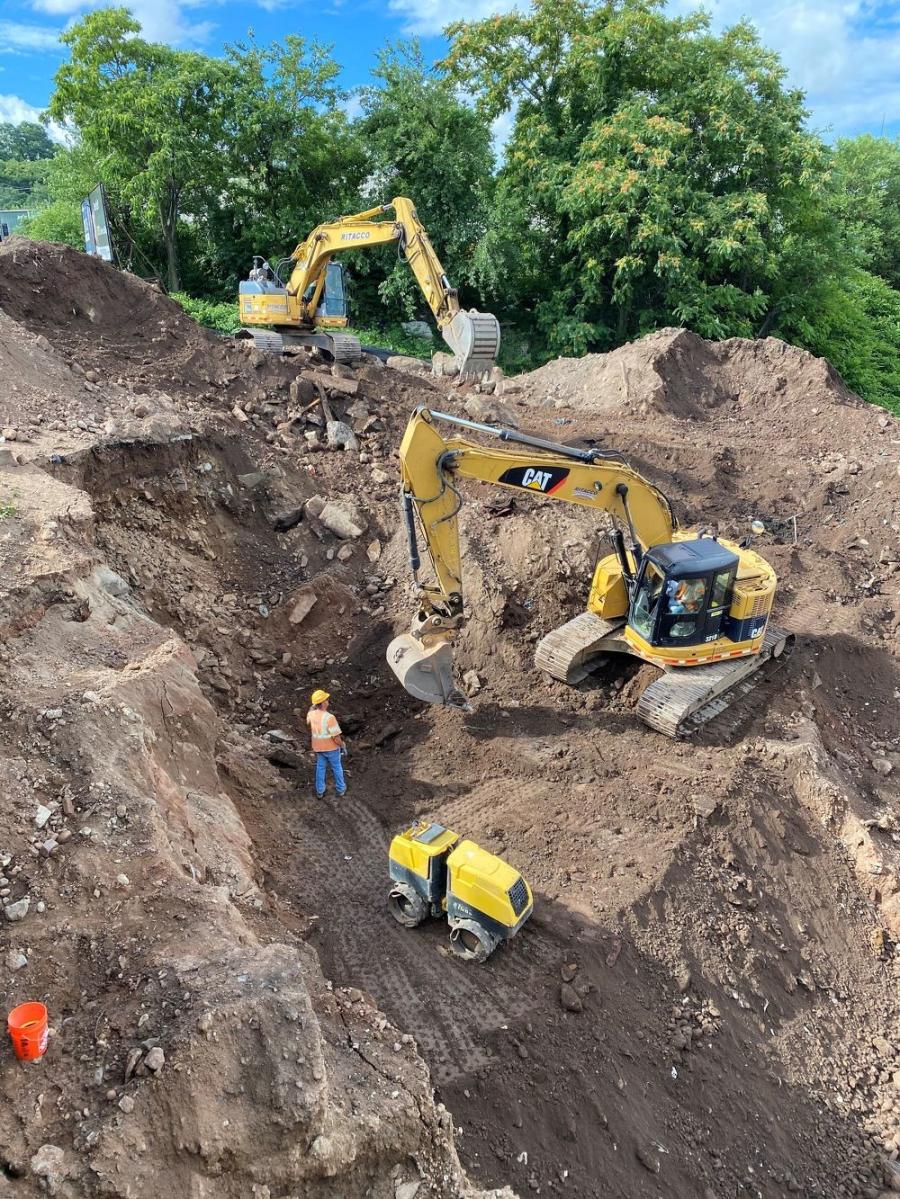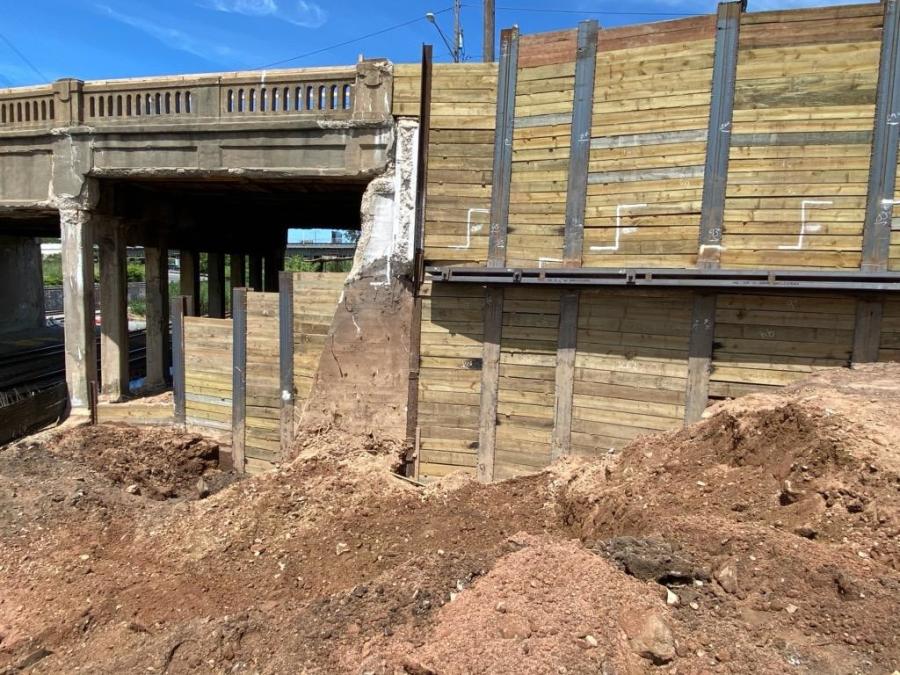Crews excavate large boulder obstructions prior to installation of wick drains for the new foundation of abutment and retaining walls on the southeast corner of the new bridge.
Crews from Ritacco Construction Inc. (RCI) started work on the $24.8 million Route 3 Bridge over Conrail and New York, Susquehanna and Western Railway (NYS&W) railroad replacement project last April 1, a three-year initiative that is taking place in the township of North Bergen (Hudson County).
Built in 1929, the old bridge (200 ft. long, 70 ft. wide and two lanes and sidewalks in each direction), which is being demolished, spans tracks operated by Conrail and NYS&W and ends at the intersection of Route 1&9. The three-year project, expected to be completed in the summer of 2023, is being funded through a federal Transportation Investment Generating Economic Recovery (TIGER) grant.
The existing bridge is located between the Route 495 Bridge over Route 3 on the west and Route 1&9/Tonnele Avenue on the east, near the south entrance to the NJ Transit North Bergen Park & Ride lot.
"The project will address the poor condition and geometric deficiencies of the bridge," said Steve Schapiro, NJDOT's deputy manager of communications. "The bridge deck and piers are both in poor condition and both sidewalks have been closed to pedestrian traffic due to the deterioration."
The new, wider bridge will be a single-span structure with an approximate length of 156 ft. and minimum vertical under-clearance of 23 ft. over the tracks and 16 ft. 6 in. over the ramp from Route 3 westbound to Route 495 eastbound. It will have two 12-ft. lanes, a 4-ft. left shoulder and 10-ft. minimum right shoulder in each direction. The existing roadway also will be widened to the south to accommodate the wider bridge.
"Using a single-span design will eliminate the piers adjacent to the railroad tracks," said Schapiro. "This will improve rail service by allowing freight trains to transport higher and wider loads, as well as travel at higher speeds. Eliminating the existing pier also will create increase spacing between the tracks, which is required to provide shared passenger and freight service. This expanded passenger and freight service will provide significant regional benefits to commuters and the freight industry from Passaic, Bergen, and Hudson counties.
"[It will also] improve motorist safety by providing standard lane and shoulder widths and improved site distance," he added. "The sidewalk will be extended to connect the existing sidewalk on Route 1&9/Tonnele Avenue to the North Bergen Park and Ride."
Other elements have RCI replacing the ramp from Route 3 westbound to Route 495 eastbound.
Michael Baker International designed the new bridge and road infrastructure. The current bridge handles more than 113,000 cars and trucks daily.
"One of the design challenges was providing a design that poses the least amount of impact to the railroads below, as well as to the motorists," said Schapiro. "The design keeps traffic on the bridge during construction and eliminates the middle pier to allow the railroad more space for future expansion."
The expected lifespan of the new bridge is 75 years.
The project is being constructed in five stages to help NJDOT mitigate the traffic impacts, especially as the neighboring Route 495 bridge project continues. Route 495 connects directly to the Lincoln Tunnel.
So far, RCI has completed the following elements: site clearing, temporary sheeting and excavation on south side for new south abutments and retaining walls.
"During Stage 1, a portion of the proposed bridge and approach roadway will be constructed to the south of the existing bridge," said Schapiro. "Traffic will be maintained on the existing bridge during this stage. Other work to be completed during Stage 1 include utility work; temporary repairs to the sidewalk on the north side of the bridge; removal of a portion of the existing structure; drainage work; construction of abutments and approach roadway; lighting; and replacement of the existing overhead sign structure.
"During Stage 2 the center portion of the bridge and approach roadway will be built by shifting the eastbound traffic to the new bridge section built in Stage 1," he added. "Westbound traffic will be maintained on the existing structure. During Stage 3 the final portion of the bridge and approach roadway will be built by shifting the westbound traffic to the new structure completed in Stage 2. Eastbound traffic will be unaffected. Other work to be completed during this stage includes construction of sidewalks and ADA ramps and traffic signals."
Stage 4 will have crews build the median on the approach roadway and proposed island with a sidewalk and ADA ramps, by shifting the westbound traffic onto the new structure completed in Stage 3.
"Stage 5 includes pavement work and final cleanup," said Schapiro,
During Stage 1, construction of the new bridge will be done adjacent to the existing bridge to minimize the impact to traffic.
"One of the main challenges is coordinating the bridge work with the two railroads below," said Schapiro. "NJDOT will work in cooperation with the railroads to schedule outages and flaggers. In addition, much of the work will be done during non-peak hours to minimize the effect on traffic. The project requires close coordination with adjacent projects (Route 495 Viaduct project) and agencies such as the NJ Turnpike, NJ Transit, Port Authority of New York and New Jersey and a separate paving project on Route 3. There also are overhead transmission lines requiring coordination with utilities.
"Most work will take place during the day, although there is some work that will take place at night or on weekends due to traffic and railroad access," he added, noting that while crews will be working throughout the winter, most of those activities will be done via day shifts.
There are some minor electric and water main relocations.
Ritacco crews have limited work space.
"The work zone is over railroad tracks and the traffic lanes are narrow, and it is near the busy interchange of Route 3 and Routes 1 and 9, as well Route 495 and the NJ Transit Park and Ride," said Schapiro.
During Stage 1, the new bridge will be constructed adjacent to the existing bridge to minimize the impact to traffic.
"The demolition will be done in stages as we work across the bridge," said Schapiro. "A new bridge for eastbound traffic will be built this year, then the existing south side of the bridge will be demolished. Work to construct the new bridge will continue and then the north side of the bridge will be demolished the following year."
Temporary shielding has been installed under the bridge to prevent debris from falling on the road and tracks. Due to limited space on site to store the demolition debris, some materials will be removed the same day, while some will be stored on site until it can be removed.
The amounts of concrete, asphalt and steel to be generated from the demolition are still being tabulated, as are the amounts of new building materials that will be brought in.
"Steel will be recycled off site and concrete, most likely will be recycled as well," said Schapiro. "NJDOT supports recycling materials when possible, and encourages contractors to do so."
Peak days will have many RCI and subcontractor employees on site. The general contractor has brought in regional and local subcontractors on board to assist with the work.
Equipment being used includes standard front-end loaders, backhoes, pile driving equipment, cranes of various sizes and a wick drain installation rig.
The firm purchases and rents equipment from local and regional dealerships. CEG
Irwin Rapoport
A journalist who started his career at a weekly community newspaper, Irwin Rapoport has written about construction and architecture for more than 15 years, as well as a variety of other subjects, such as recycling, environmental issues, business supply chains, property development, pulp and paper, agriculture, solar power and energy, and education. Getting the story right and illustrating the hard work and professionalism that goes into completing road, bridge, and building projects is important to him. A key element of his construction articles is to provide readers with an opportunity to see how general contractors and departments of transportation complete their projects and address challenges so that lessons learned can be shared with a wider audience.
Rapoport has a BA in History and a Minor in Political Science from Concordia University. His hobbies include hiking, birding, cycling, reading, going to concerts and plays, hanging out with friends and family, and architecture. He is keen to one day write an MA thesis on military and economic planning by the Great Powers prior to the start of the First World War.
Read more from Irwin Rapoport here.
Today's top stories

















